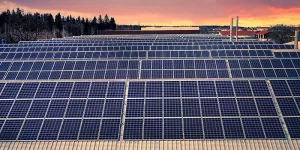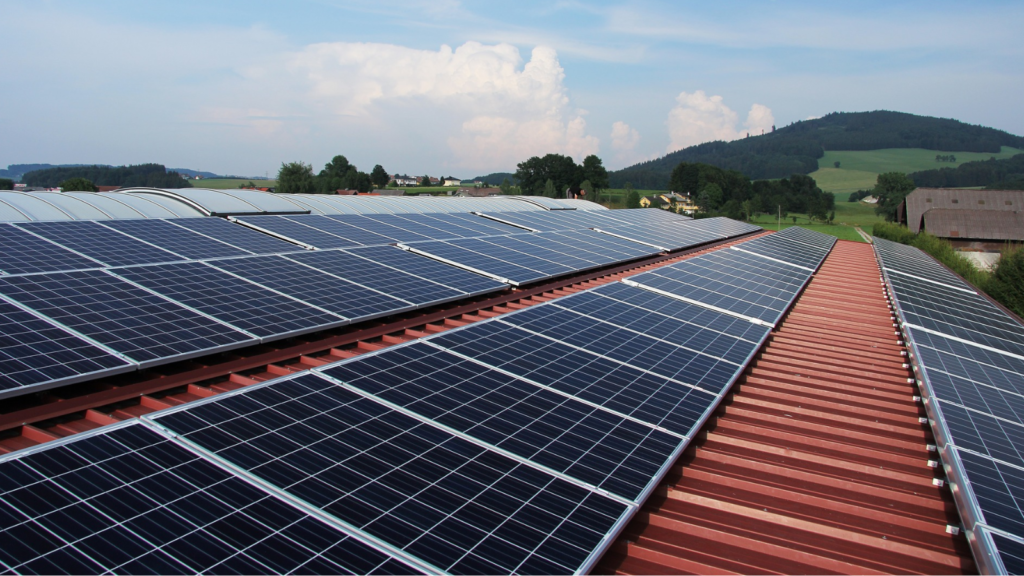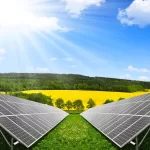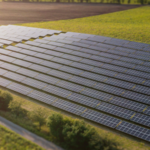Table of Contents
Introduction
As global awareness of climate change grows, both private companies and governments are increasingly turning to green and sustainable energy sources. There is a noticeable shift away from coal and gas power plants towards environmentally friendly options such as wind, thermal, and solar energy farms. While wind farms can generate noise pollution near residential and commercial areas, solar energy production is favored for its quieter operation. However, even solar farms can contribute to noise pollution, highlighting the ongoing necessity for effective noise mitigation solutions in renewable energy infrastructure.
Misunderstandings About Noise Pollution from Photovoltaic Stations
A photovoltaic power station, also known as a solar park, solar farm, or solar power plant, is a large-scale grid-connected photovoltaic power system (PV system) designed for the supply of merchant power. They are different from most building-mounted and other decentralized solar power because they supply power at the utility level, rather than to a local user or users. The construction and operation of PV stations play a crucial role in reducing reliance on fossil fuels, enhancing energy security, and combating climate change. However, as the importance of sustainable energy grows, PV stations, as a significant part of clean energy, face some misconceptions and myths about noise pollution:
Do PV stations generate continuous high-frequency noise?
Many believe that PV stations produce continuous high-frequency noise during operation, severely affecting the quality of life of nearby residents. In reality, PV stations do generate some noise, but it is generally low-frequency and at a relatively low noise level. With proper design and soundproofing, the impact of PV station noise on the environment is minimal.
Does the noise from PV stations affect human health?
Research indicates that the noise levels of PV stations are typically lower than those of urban traffic and industrial noise, posing negligible health risks. As long as national and local environmental noise standards are met, the noise from PV stations does not significantly threaten residents’ health.
Do PV stations produce noise at night?
Some believe that PV stations continue to generate noise at night, affecting sleep and the nervous system. In reality, PV stations primarily operate during the day when there is sufficient sunlight and generally cease operations at night. Equipment such as inverters and cooling systems do not run at night.
Is noise from PV stations unavoidable through technical means?
There is a belief that noise from PV stations is inevitable and cannot be effectively reduced through technical measures. In fact, with ongoing technological advancements, noise control in PV stations has continually improved. By selecting low-noise equipment, planning installation locations rationally, and implementing soundproofing measures, PV station noise can be kept within reasonable limits.

What Are the Main Sources of Noise in PV Stations?
PV stations, while beneficial for renewable energy production, are not completely silent. The primary culprits behind this ambient sound are inverters and transformers.
Inverters:
Inverters play a crucial role in converting direct current (DC) produced by solar panels into alternating current (AC) for integration into the local grid. This conversion involves rapid switching of electrical flow, which generates noise. The switches operate at a frequency of 60 cycles per second (60 Hz), resulting in tonal sounds at 120 Hz and its harmonics (240 Hz, 360 Hz, 480 Hz, etc.). These tonal noises are due to the fast switching process required for efficient power conversion.
Transformers:
Transformers in photovoltaic stations are responsible for stepping up voltage to facilitate transmission into the local grid. The noise from transformers generally arises from three sources: core noise, coil noise, and fan noise. Core and coil noise are generated by electromagnetic forces that occur twice per AC power cycle, resulting in a primary noise frequency of 120 Hz, along with its harmonics.
Movements in other mechanical components in the inverter and transformer, like coil vibrations and high-speed cooling fans, contribute to the body and level of noise. These mechanical actions, though secondary to the primary noise sources, add to the continuous ambient sound produced by the station’s operation.
Effective Solutions for PV Stations Noise Reduction
Reducing noise from photovoltaic (PV) stations is crucial for minimizing their impact on nearby communities. Here are several effective strategies for achieving noise reduction:
1. Acoustic Enclosures
Encasing inverters and transformers in acoustic enclosures can substantially reduce noise emissions. These enclosures are designed to absorb and contain sound, preventing it from escaping into the environment. They are particularly effective for managing noise from equipment with continuous operation.
2. Upgraded Equipment
Investing in modern, quieter inverters and transformers can help lower noise levels. Newer models often feature advanced noise-reduction technologies, such as improved cooling systems and quieter switching mechanisms, which reduce the amount of noise generated during operation.
3. Strategic Equipment Placement
Positioning noisy equipment away from residential areas and sensitive locations can help minimize noise impact. Placing inverters and transformers in dedicated rooms or enclosed areas, preferably with soundproofing materials, further helps in controlling noise.
4. Routine Maintenance
Regular maintenance of PV station equipment ensures that mechanical components operate smoothly and quietly. Routine checks and servicing of cooling fans, transformers, and inverters help prevent noise caused by wear and tear or malfunctioning parts.
5. Noise-Absorbing Materials
Using noise-absorbing materials in the construction of PV stations can significantly reduce sound transmission. Incorporating these materials into walls, ceilings, and flooring helps dampen noise and improve overall acoustic comfort.
6. Vegetative Barriers
Creating vegetative barriers, such as planting trees and shrubs around the PV station, acts as a natural sound barrier. Plants absorb and deflect sound waves, which can effectively reduce noise levels for neighboring areas.
7. Advanced Sound Monitoring
Implementing noise monitoring systems allows for continuous tracking of sound levels. These systems can provide real-time data and alerts when noise exceeds acceptable thresholds, enabling prompt action to address and mitigate noise issues.
By applying these noise reduction techniques, PV stations can operate more harmoniously within their environments, ensuring minimal disturbance to nearby residents and wildlife.

Compliance and Regulations for PV Station Noise
Various standards and regulations have been established across countries and regions to manage and control noise emissions from photovoltaic (PV) stations, ensuring that their impact on the surrounding environment remains within acceptable limits. The following outlines key standards and regulations in Europe and specific countries that address noise management requirements for PV stations:
1. European Standards (EN Standards)
- EN 61672-1:2013– This standard establishes the performance requirements for sound level meters used to measure noise accurately, ensuring that noise emissions from PV stations are properly assessed.
- EN 12354– This standard provides guidelines on building acoustics, focusing on sound insulation within buildings, which helps in understanding and mitigating noise within the structures housing PV equipment.
2. EU Regulations
- EU Environmental Noise Directive (END) 2002/49/EC– This directive requires EU member states to evaluate and manage environmental noise, including that from industrial installations like PV stations. It mandates the creation of noise maps and noise management plans to address and reduce noise pollution.For industrial areas, the typical allowable daytime noise levels are within 60-70 dB(A), and nighttime levels are within 50-60 dB(A) (specific requirements may vary by region).
- EU Machinery Noise Directive (2000/14/EC)– This directive regulates the noise emissions of machinery, including equipment used in PV stations. It sets permissible noise levels and requires manufacturers to provide noise data for their equipment.For machinery noise, the typical limits range from 70-80 dB(A), depending on the type and use of the equipment.
3. National Regulations
- Germany: The Federal Immission Control Act (BImSchG) and the Technical Instructions on Noise (TA Lärm) regulate noise emissions from industrial facilities, including PV stations, setting specific limits and requirements for noise control.Near residential areas, daytime noise levels are generally not to exceed 50-55 dB(A), and nighttime levels should not exceed 35-40 dB(A).
- France: The Environmental Code (Code de l’environnement) oversees noise management and provides guidelines for monitoring and controlling noise pollution. Local authorities may implement additional noise control measures specific to PV stations.In residential areas, typical noise limits are 55 dB(A) during the day and 45 dB(A) at night.
- United Kingdom: The Noise Act 1996 and the Environmental Protection Act 1990 establish regulations for noise levels and noise control measures, applicable to PV stations and other industrial activities.In residential areas, daytime noise levels typically should not exceed 50-55 dB(A), and nighttime levels should be below 40-45 dB(A).
4. Local and Regional Regulations
- Local Regulations: Many regions and municipalities have their own specific noise regulations that may impose stricter limits or additional requirements for noise control in PV stations. These can include zoning laws, building permit conditions, and local environmental protection rules. Local noise regulations’ specific decibel limits vary by region, often imposing stricter limits for industrial noise.
Overall, compliance with these standards and regulations ensures that PV stations operate within acceptable noise levels, protecting both the environment and nearby communities from excessive noise pollution.
Conclusion
Noise pollution from photovoltaic power stations, though generally less severe than in other industrial contexts, is an important factor to consider for the successful implementation of solar energy projects. By understanding the sources of noise, assessing their impact, and employing effective noise reduction strategies, PV power stations can operate more harmoniously within their environments. Adherence to regulatory standards and ongoing advancements in technology will further aid in minimizing noise pollution, supporting a more sustainable and community-friendly approach to renewable energy.
Since 2008, Maysun Solar has been dedicated to producing high-quality photovoltaic modules, including Twisun Pro, TOPCon, IBC, and HJT solar panels, as well as balcony solar power stations. Our products are designed with a focus on noise reduction, ensuring low noise operation for a quieter home solar experience. All Maysun solar panels are CE and TUV certified, offering exceptional performance and stylish designs that seamlessly integrate with any building. We have established offices and warehouses in several European countries and maintain long-term partnerships with top installers. For the latest component quotes or any photovoltaic-related inquiries, please contact us—we are here to help.
Reference
Clockwork. (2023, March 23). Yes, solar farms can produce noise! Acentech. https://www.acentech.com/resources/yes-solar-farms-can-produce-noise/
Authority, C. S. (2024, January 1). Solar farm noise recommendations. Community Solar Authority. https://communitysolarauthority.com/solar-farm-noise-recommendations/
Systems, S. F. (2024, July 3). Solar farm noise control solutions and noise mitigation. Sound Fighter Systems. https://www.soundfighter.com/solar-farm-noise-reduction/
Wikipedia contributors. (2024, March 29). Photovoltaic power station. Wikipedia. https://en.wikipedia.org/wiki/Photovoltaic_power_station

Will Agrivoltaics Affect Crop Growth?
Agrivoltaics combines solar energy and agriculture to reduce up to 700 tons of CO₂ per MW, improve water use, and boost crop growth for sustainable farming.

6.5 Billion Loss Hits Photovoltaics: Reshaping or Elimination?
In 2025, the photovoltaic market may see a turnaround as some companies take early action. A €6.5 billion loss is driving businesses to explore new growth areas like energy storage and hydrogen. Which giants will break through? Industry transformation is accelerating!

What’s New in Solar Energy (March 2025)
March’s solar news highlights include rooftop solar meeting two-thirds of global demand, China’s market reforms potentially boosting solar demand and module prices, France revising solar targets in PPE 3, and challenges in Europe with declining capture rates and price volatility.

Zero-Investment Solar Projects: How to Earn Passive Income Through Rooftop Leasing?
Monetize your idle rooftop and earn stable annual rent! With the photovoltaic rooftop leasing model, businesses can generate long-term revenue without investment, reduce operating costs, and achieve a green transition.

How to Optimize Photovoltaic Power Plant Operations with AI and Big Data
This article explores three methods of using AI to enhance power generation revenue and reduce operation and maintenance costs in intelligent photovoltaic operations.

Solar Module Costs May Rise by 10% in 2026! In-Depth Analysis of CBAM’s Impact on the Industry
Table of Contents Introduction to CBAM 1. Why Did the EU Introduce CBAM? As the challenges posed by global climate change intensify, governments worldwide are accelerating their efforts to achieve carbon neutrality. The European Union, a leader in global carbon reduction initiatives, introduced



